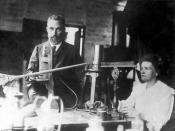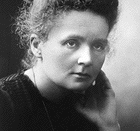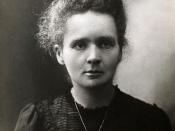Becquerel
In 1896, Becquerel's earlier work was surpassed by his discovery of the occurrence of natural radioactivity. Becquerel decided to investigate whether there was any connection between X-rays and naturally occurring phosphorescence, after his discussion with Henri Poincaré on the radiation which had been recently discovered by Röntgen (X-rays) and which was accompanied by a type of phosphorescence in the vacuum tube. He had inherited from his father a supply of uranium salts, which exhibits phosphorescence upon exposure to light. When the salts were placed near to a photographic plate covered with opaque paper, the plate was found to be fogged. The phenomenon was found to be common to all the uranium salts studied and was concluded to be a property of the uranium atom. Later, Becquerel showed that the rays emitted by uranium caused gases to ionize and that they differed from X-rays in that they could be deflected by electric or magnetic fields.
For his discovery of spontaneous radioactivity Becquerel was awarded half of the Nobel Prize for Physics in 1903, the other half was given to Pierre and Marie Curie for their study of Becquerel's radiation.
Rutherford
Rutherford was awarded the Nobel Prize for his ground-breaking work in nuclear physics. In 1909, while at the University of Manchester, Rutherford overran a thin gold foil with alpha particles when he noticed that although almost all of them went through the gold, one in eight thousand would "bounce" back. A shocked Rutherford commented that it was "as if you fired a 15-inch naval shell at a piece of tissue paper and the shell came right back and hit you." From this straightforward observation, Rutherford concluded that the atom's mass must be concentrated in a tiny, positively-charged nucleus, while the electrons occupy the farthest ranges of the atom.


